Estimation of the Compressive Strength of Corrugated Board Boxes with Shifted Creases on the Flaps
Abstract
1. Introduction
2. Materials and Methods
2.1. Corrugated Board Packaging with Shifted Flaps
2.2. Laboratory Testing of Corrugated Board
2.3. Corrugated Board: Material Model and Constitutive Parameters
2.4. Numerical Predictive Model
2.5. Analytical Predictive Model
2.6. Calibration Procedure
3. Results
3.1. Corrugated Board: Material Testing
3.2. Box Compression Test (BCT)
3.3. Prediction Results of the Numerical Model
3.4. Prediction Results of the Analytical Model
4. Discussion
5. Conclusions
Author Contributions
Funding
Institutional Review Board Statement
Informed Consent Statement
Data Availability Statement
Acknowledgments
Conflicts of Interest
References
- Garbowski, T.; Gajewski, T.; Grabski, J.K. Estimation of the compressive strength of corrugated cardboard boxes with various perforations. Energies 2021, 14, 1095. [Google Scholar] [CrossRef]
- Garbowski, T.; Gajewski, T.; Grabski, J.K. Estimation of the compressive strength of corrugated cardboard boxes with various openings. Energies 2021, 14, 155. [Google Scholar] [CrossRef]
- Sohrabpour, V.; Hellström, D. Models and Software for Corrugated Board and Box Design. In Proceedings of the 18th International Conference on Engineering Design (ICED 11), Copenhagen, Denmark, 15–18 October 2011. [Google Scholar]
- Kellicutt, K.; Landt, E. Development of design data for corrugated fiberboard shipping containers. Tappi J. 1952, 35, 398–402. [Google Scholar]
- Maltenfort, G. Compression strength of corrugated containers. Fibre Contain. 1956, 41, 106–121. [Google Scholar]
- McKee, R.C.; Gander, J.W.; Wachuta, J.R. Compression strength formula for corrugated boxes. Paperboard Packag. 1963, 48, 149–159. [Google Scholar]
- Allerby, I.M.; Laing, G.N.; Cardwell, R.D. Compressive strength—From components to corrugated containers. Appita Conf. Notes 1985, 1–11. [Google Scholar]
- Schrampfer, K.E.; Whitsitt, W.J.; Baum, G.A. Combined Board Edge Crush (ECT) Technology; Institute of Paper Chemistry: Appleton, WI, USA, 1987. [Google Scholar]
- Batelka, J.J.; Smith, C.N. Package Compression Model; Institute of Paper Science and Technology: Atlanta, GA, USA, 1993. [Google Scholar]
- Urbanik, T.J.; Frank, B. Box compression analysis of world-wide data spanning 46 years. Wood Fiber Sci. 2006, 38, 399–416. [Google Scholar]
- Garbowski, T.; Gajewski, T.; Grabski, J.K. The role of buckling in the estimation of compressive strength of corrugated cardboard boxes. Materials 2020, 13, 4578. [Google Scholar] [CrossRef] [PubMed]
- Frank, B. Corrugated box compression—A literature survey. Packag. Technol. Sci. 2014, 27, 105–128. [Google Scholar] [CrossRef]
- Stott, R.A. Compression and stacking strength of corrugated fibreboard containers. Appita J. 2017, 70, 76–82. [Google Scholar]
- Junli, W.; Quancheng, Z. Effect of moisture content of corrugated box on mechanical properties. J. Lanzhou Jiaotong Univ. 2006, 25, 134–136. [Google Scholar]
- Archaviboonyobul, T.; Chaveesuk, R.; Singh, J.; Jinkarn, T. An analysis of the influence of hand hole and ventilation hole design on compressive strength of corrugated fiberboard boxes by an artificial neural network model. Packag. Technol. Sci. 2020, 33, 171–181. [Google Scholar] [CrossRef]
- Zhang, Y.-L.; Chen, J.; Wu, Y.; Sun, J. Analysis of hazard factors of the use of corrugated carton in packaging low-temperature yogurt during logistics. Procedia Environ. Sci. 2011, 10, 968–973. [Google Scholar] [CrossRef]
- Nordstrand, T.; Carlsson, L. Evaluation of transverse shear stiffness of structural core sandwich plates. Compos. Struct. 1997, 37, 145–153. [Google Scholar] [CrossRef]
- Nordstrand, T. Basic Testing and Strength Design of Corrugated Board and Containers. Ph.D. Thesis, Lund University, Lund, Sweden, 2003. [Google Scholar]
- Avilés, F.; Carlsson, L.A.; May-Pat, A. A shear-corrected formulation of the sandwich twist specimen. Exp. Mech. 2012, 52, 17–23. [Google Scholar] [CrossRef]
- Garbowski, T.; Gajewski, T.; Grabski, J.K. Role of transverse shear modulus in the performance of corrugated materials. Materials 2020, 13, 3791. [Google Scholar] [CrossRef] [PubMed]
- Garbowski, T.; Gajewski, T.; Grabski, J.K. Torsional and transversal stiffness of orthotropic sandwich panels. Materials 2020, 13, 5016. [Google Scholar] [CrossRef] [PubMed]
- Urbanik, T.J.; Saliklis, E.P. Finite element corroboration of buckling phenomena observed in corrugated boxes. Wood Fiber Sci. 2003, 35, 322–333. [Google Scholar]
- Garbowski, T.; Jarmuszczak, M. Homogenization of corrugated paperboard. Part 1. Analytical homogenization. Pol. Pap. Rev. 2014, 70, 345–349. (In Polish) [Google Scholar]
- Garbowski, T.; Jarmuszczak, M. Homogenization of corrugated paperboard. Part 2. Numerical homogenization. Pol. Pap. Rev. 2014, 70, 390–394. (In Polish) [Google Scholar]
- Garbowski, T.; Marek, A. Homogenization of Corrugated Boards through Inverse Analysis. In Proceedings of the 1st International Conference on Engineering and Applied Sciences Optimization, Kos Island, Greece, 4–6 June 2014; pp. 1751–1766. [Google Scholar]
- Marek, A.; Garbowski, T. Homogenization of sandwich panels. Comput. Assist. Methods Eng. Sci. 2015, 22, 39–50. [Google Scholar]
- Garbowski, T.; Gajewski, T. Determination of Transverse Shear Stiffness of Sandwich Panels with a Corrugated Core by Numerical Homogenization. Materials 2021, 14, 1976. [Google Scholar] [CrossRef] [PubMed]
- Hohe, J. A direct homogenization approach for determination of the stiffness matrix for microheterogeneous plates with application to sandwich panels. Compos. Part B 2003, 34, 615–626. [Google Scholar] [CrossRef]
- Buannic, N.; Cartraud, P.; Quesnel, T. Homogenization of corrugated core sandwich panels. Compos. Struct. 2003, 59, 299–312. [Google Scholar] [CrossRef]
- Biancolini, M.E. Evaluation of equivalent stiffness properties of corrugated board. Compos. Struct. 2005, 69, 322–328. [Google Scholar] [CrossRef]
- Abbès, B.; Guo, Y.Q. Analytic homogenization for torsion of orthotropic sandwich plates. Appl. Compos. Struct. 2010, 92, 699–706. [Google Scholar] [CrossRef]
- Ghiţă, C.; Pop, N.; Cioban, H. Quasi-Static behavior as a limit process of a dynamical one for an anisotropic hardening material. Comput. Mater. Sci. 2012, 52, 217–225. [Google Scholar] [CrossRef]
- Thakkar, B.K.; Gooren, L.G.J.; Peerlings, R.H.J.; Geers, M.G.D. Experimental and numerical investigation of creasing in corrugated paperboard. Philos. Mag. 2008, 88, 3299–3310. [Google Scholar] [CrossRef][Green Version]
- Beex, L.A.A.; Peerlings, R.H.J. An experimental and computational study of laminated paperboard creasing and folding. Int. J. Solids Struct. 2009, 46, 4192–4207. [Google Scholar] [CrossRef]
- Giampieri, A.; Perego, U.; Borsari, R. A constitutive model for the mechanical response of the folding of creased paperboard. Int. J. Solids Struct. 2011, 48, 2275–2287. [Google Scholar] [CrossRef]
- Domaneschi, M.; Perego, U.; Borgqvist, E.; Borsari, R. An industry-oriented strategy for the finite element simulation of paperboard creasing and folding. Packag. Technol. Sci. 2017, 30, 269–294. [Google Scholar] [CrossRef]
- Awais, M.; Tanninen, P.; Leppänen, T.; Matthews, S.; Sorvari, J.; Varis, J.; Backfolk, K. A computational and experimental analysis of crease behavior in press forming process. Procedia Manuf. 2018, 17, 835–842. [Google Scholar] [CrossRef]
- Leminen, V.; Tanninen, P.; Pesonen, A.; Varis, J. Effect of mechanical perforation on the press-forming process of paperboard. Procedia Manuf. 2019, 38, 1402–1408. [Google Scholar] [CrossRef]
- FEMat BCT Press. Available online: http://fematsystems.pl/bct_en/ (accessed on 21 July 2021).
- Garbowski, T.; Jarmuszczak, M. Numerical Strength Estimate of Corrugated Board Packages. Part 1. Theoretical Assumptions in Numerical Modeling of Paperboard Packages. Pol. Pap. Rev. 2014, 70, 219–222. (In Polish) [Google Scholar]
- Garbowski, T.; Jarmuszczak, M. Numerical Strength Estimate of Corrugated Board Packages. Part 2. Experimental tests and numerical analysis of paperboard packages. Pol. Pap. Rev. 2014, 70, 277–281. (In Polish) [Google Scholar]
- Hill, R. A theory of the yielding and plastic flow in anisotropic metals. Proc. R. Soc. London. Ser. A Math. Phys. Sci. 1948, 193, 281–297. [Google Scholar] [CrossRef]
- Hoffman, O. The brittle strength of orthotropic materials. J. Compos. Mater. 1967, 1, 200–206. [Google Scholar] [CrossRef]
- Tsai, S.W.; Wu, E.M. A general theory of strength for anisotropic materials. J. Compos. Mater. 1971, 5, 58–80. [Google Scholar] [CrossRef]
- Xia, Q.S.; Boyce, M.C.; Parks, D.M. A constitutive model for the anisotropic elastic–plastic deformation of paper and paperboard. Int. J. Solids Struct. 2002, 39, 4053–4071. [Google Scholar] [CrossRef]
- Makela, P.; Ostlund, S. Orthotropic elastic–plastic material model for paper materials. Int. J. Solids Struct. 2003, 40, 5599–5620. [Google Scholar] [CrossRef]
- Borgqvist, E.; Lindström, T.; Tryding, J.; Wallin, M.; Ristinmaa, M. Distortional hardening plasticity model for paperboard. Int. J. Solids Struct. 2014, 51, 2411–2423. [Google Scholar] [CrossRef]
- Robertsson, K.; Wallin, M.; Borgqvist, E.; Ristinmaa, M.; Tryding, J. A rate-dependent continuum model for rapid converting of paperboard. Appl. Math. Model. 2021, 99, 497–513. [Google Scholar] [CrossRef]
- Abaqus Unified FEA Software. Available online: https://www.3ds.com/products-services/simulia/products/abaqus (accessed on 21 July 2021).
- FEMat BSE System. Available online: http://fematsystems.pl/bse-system_en/ (accessed on 21 July 2021).
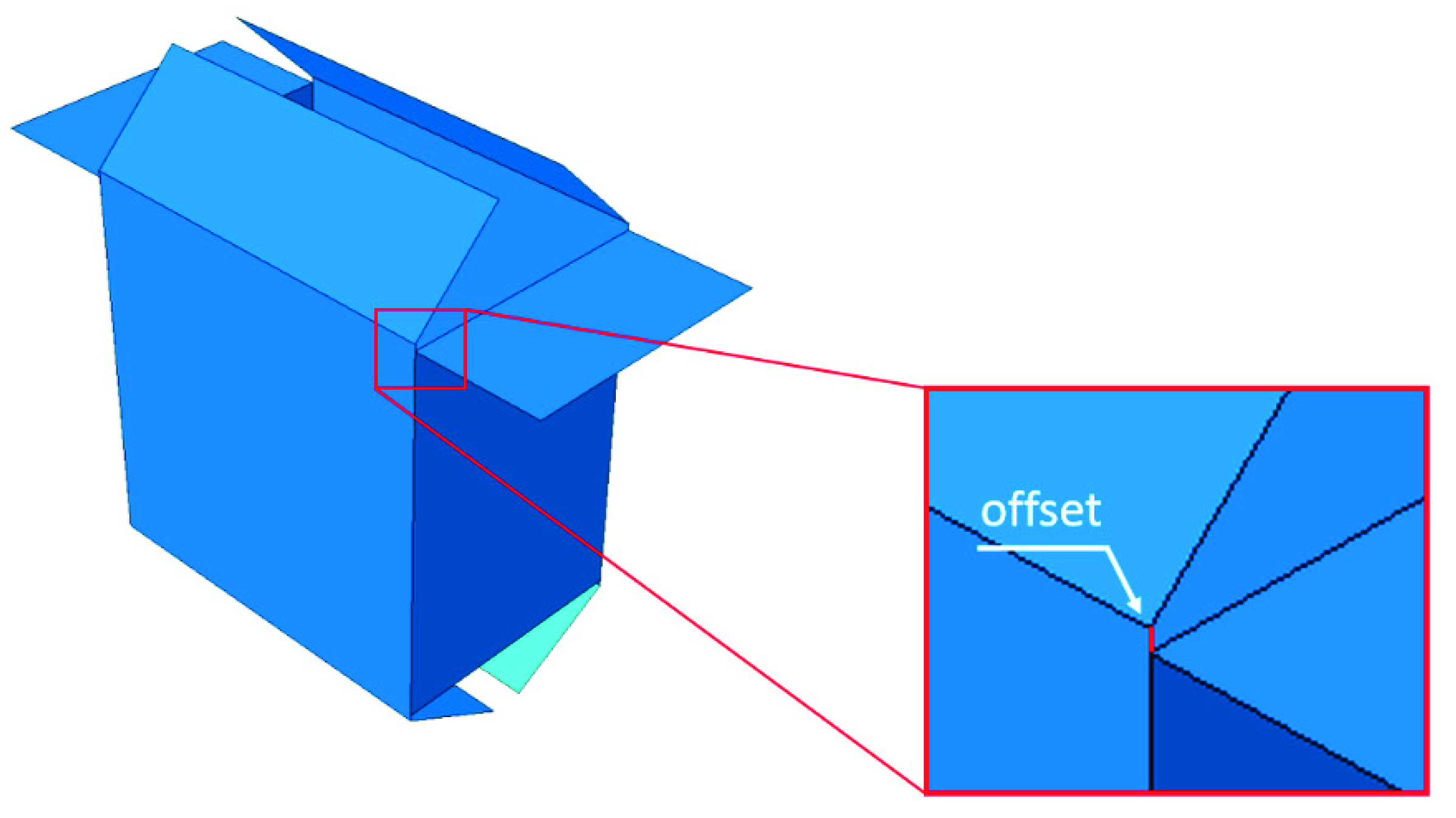
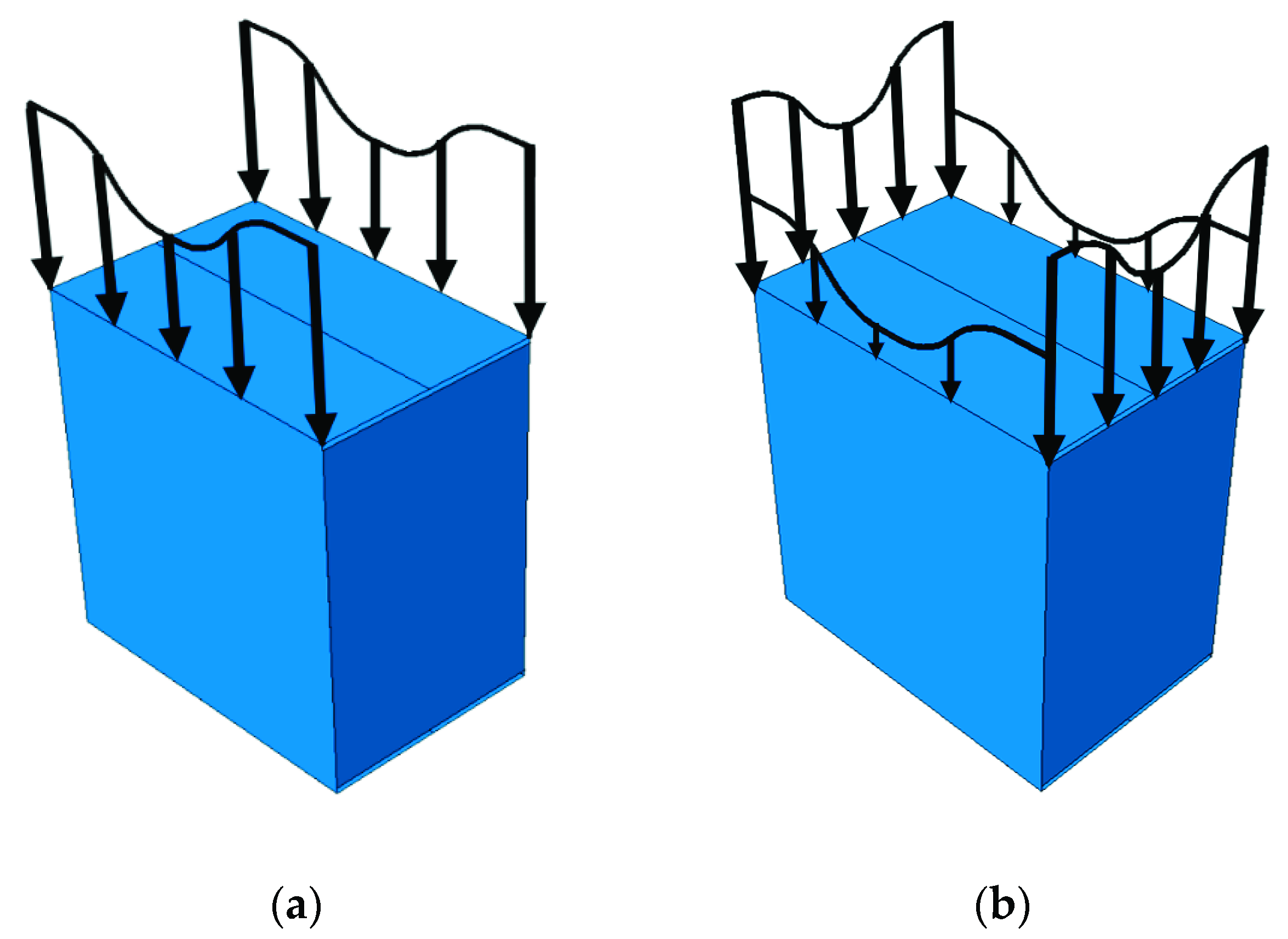
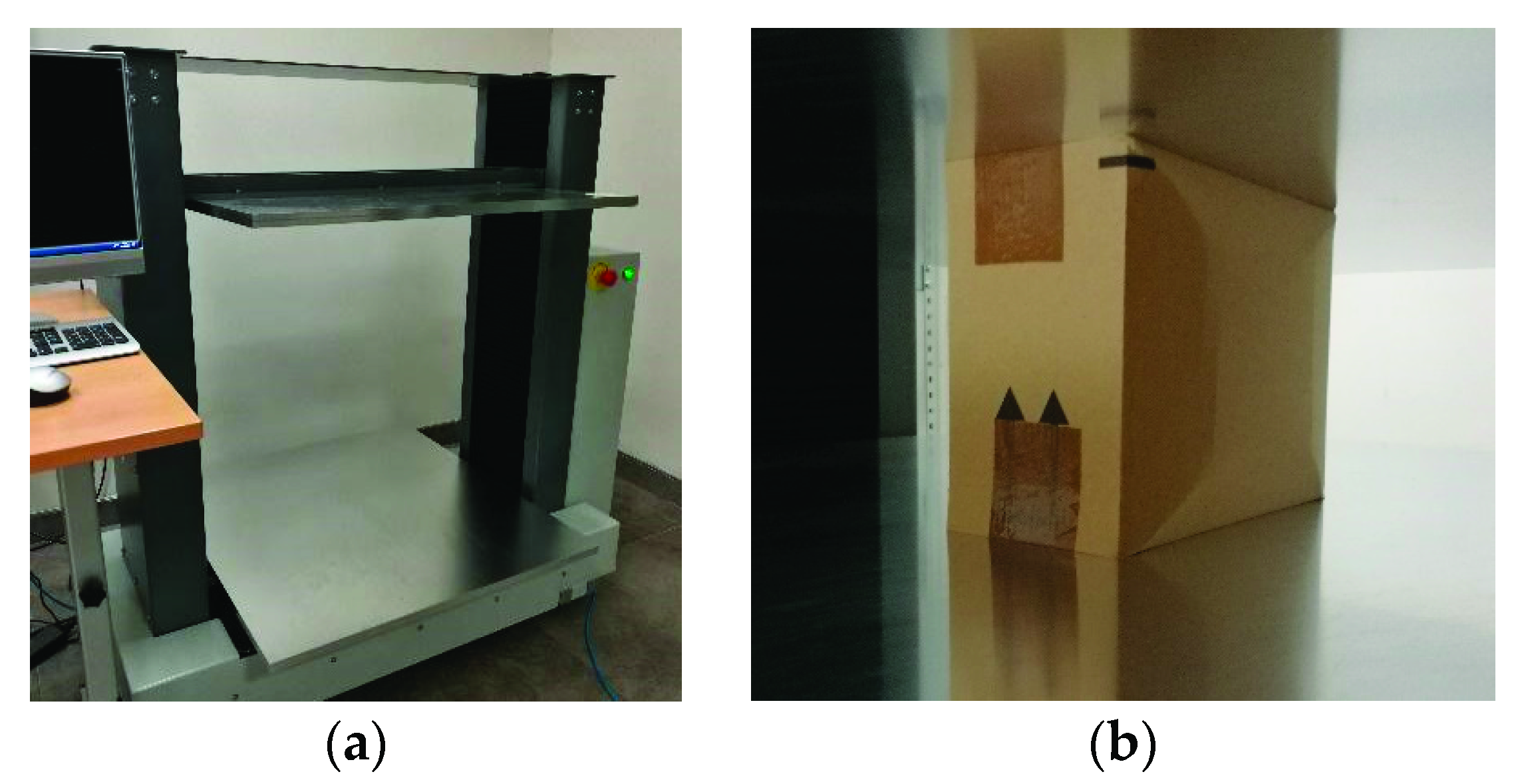

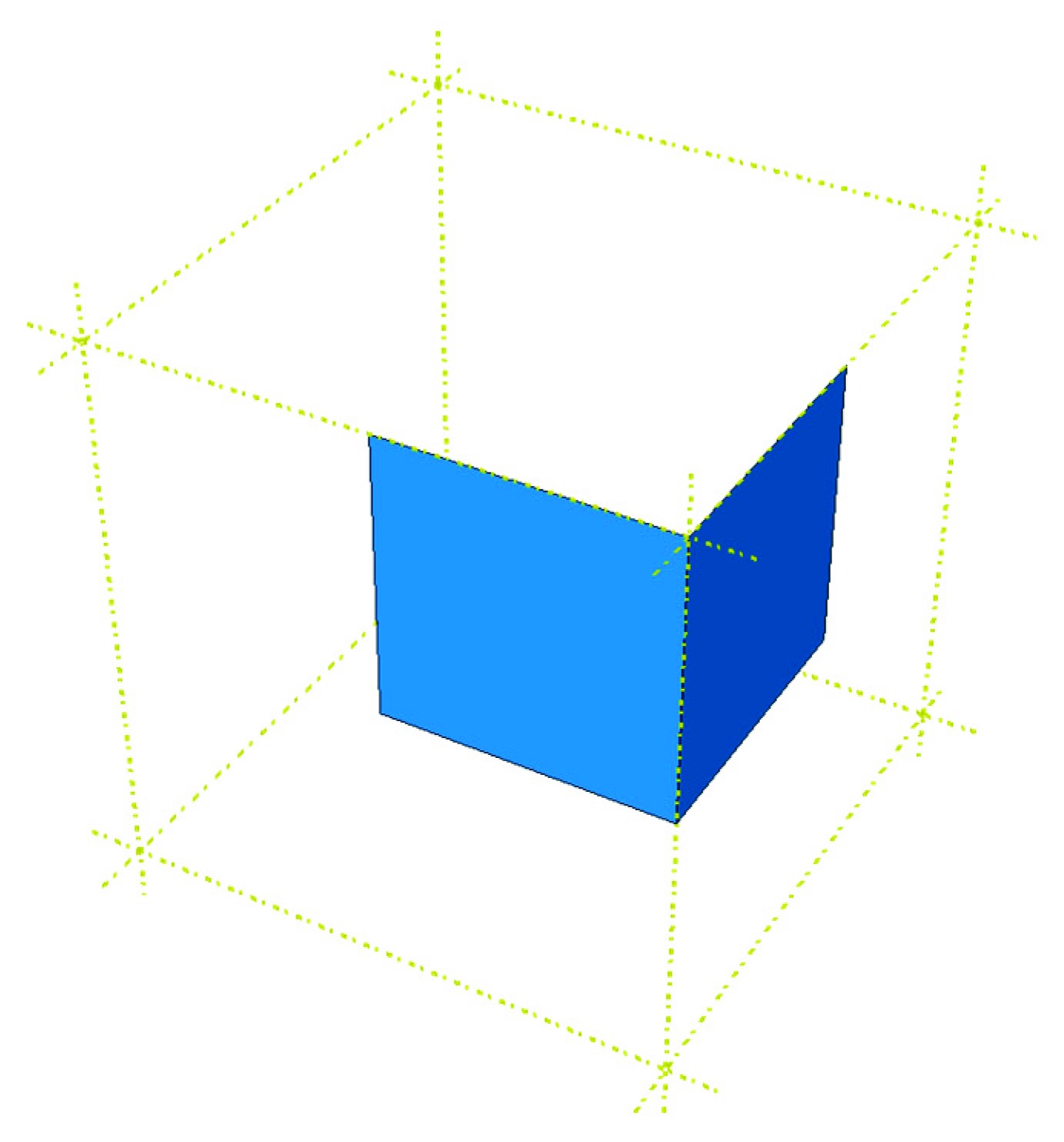
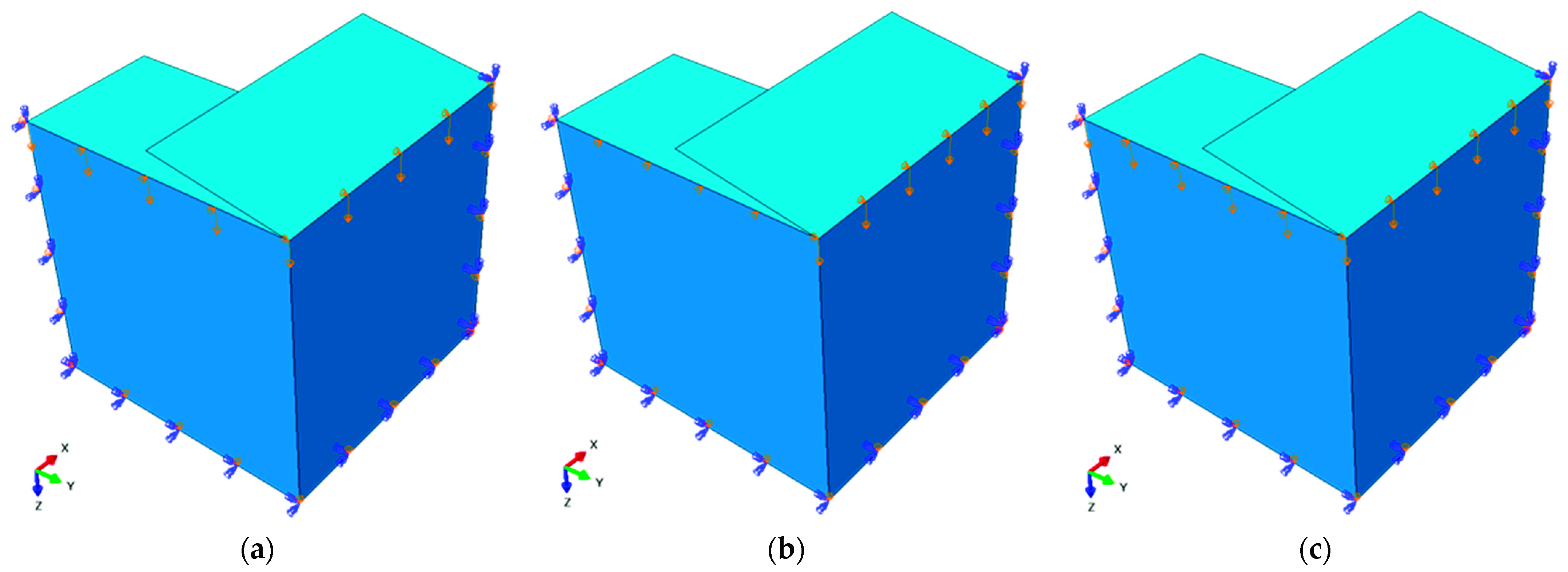

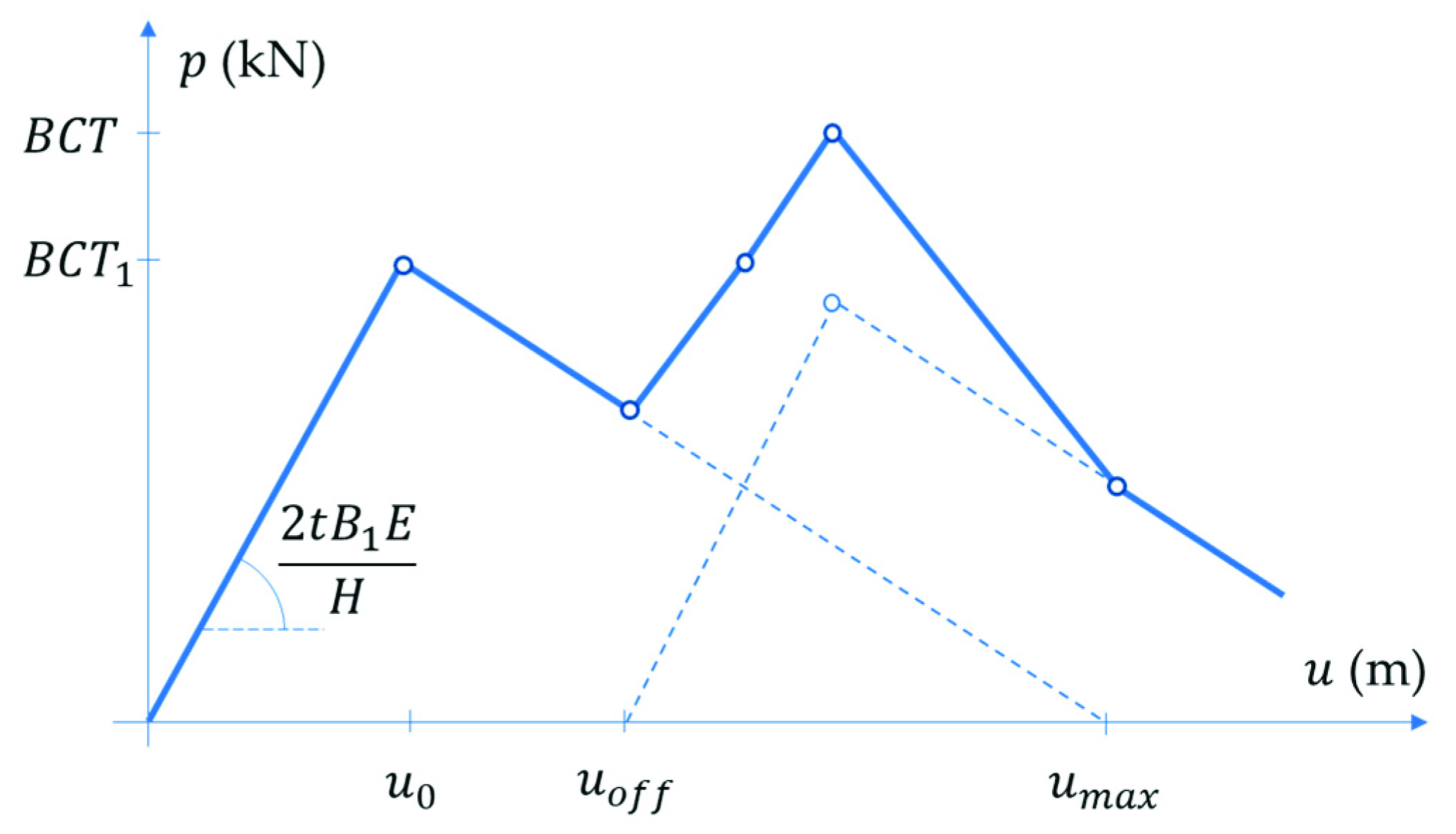

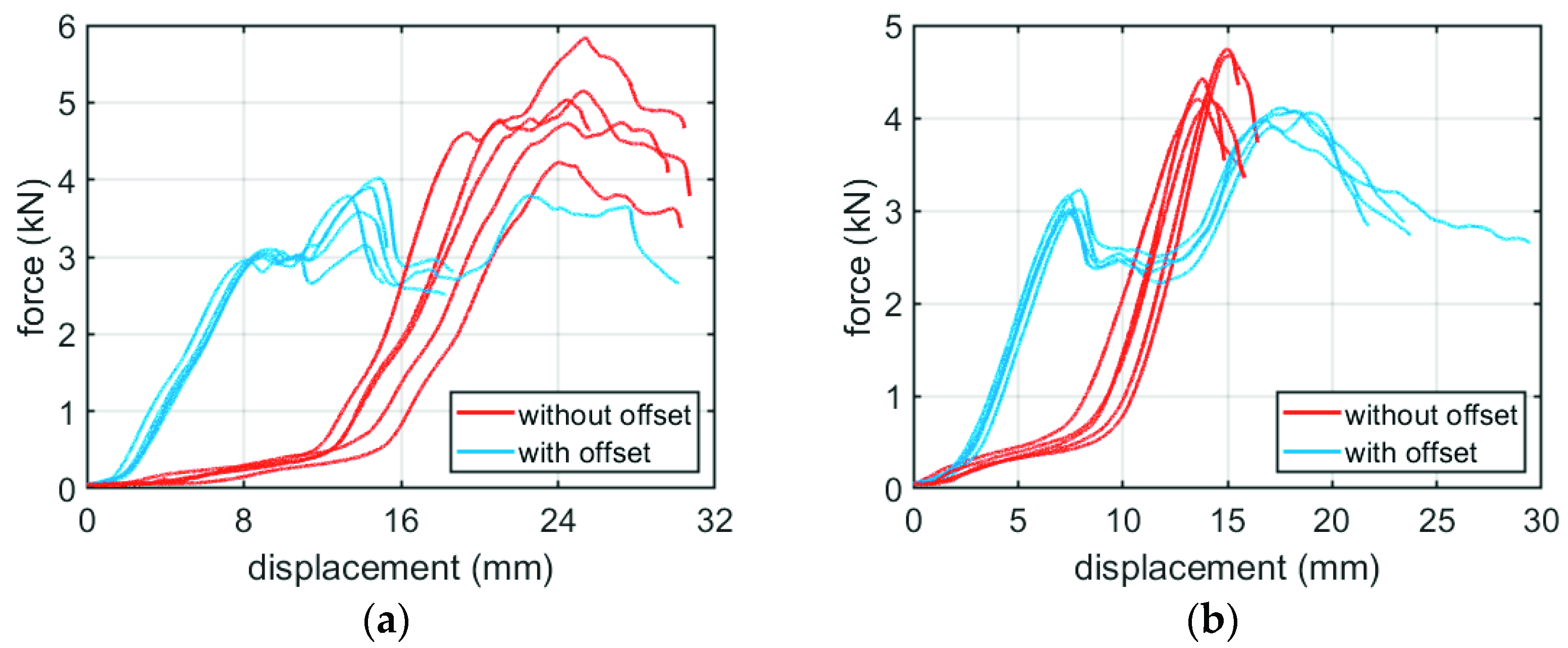


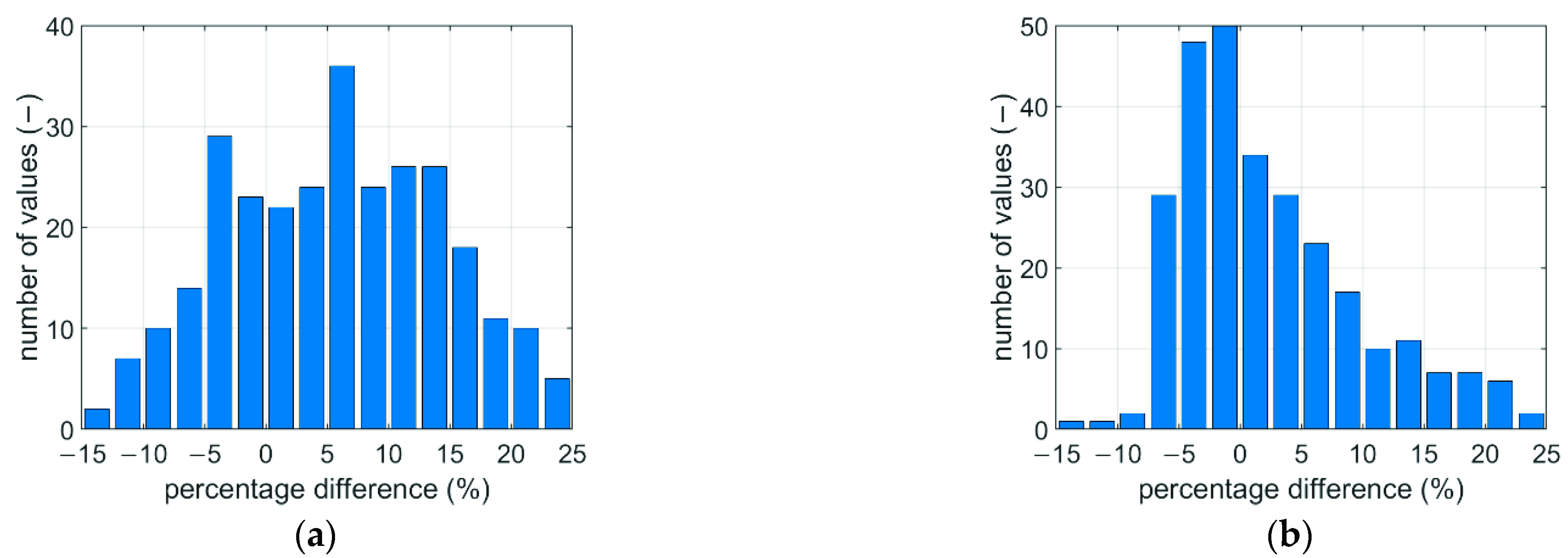


| Test | THK | ECT | BNT-MD | BNT-CD | SST-MD | SST-CD | TST-MD | TST-CD |
|---|---|---|---|---|---|---|---|---|
| 1 | 6.49 | 10.77 | 10.79 | 10.47 | 2.96 | 3.05 | 3.10 | 1.79 |
| 2 | 6.50 | 10.66 | 10.55 | 9.66 | 3.02 | 2.77 | 3.05 | 1.74 |
| 3 | 6.49 | 10.93 | 10.53 | 9.20 | 2.90 | 2.99 | 3.08 | 1.79 |
| 4 | 6.53 | 11.28 | 10.31 | 10.11 | 2.80 | 2.86 | 3.26 | 1.71 |
| 5 | 6.53 | 11.15 | 10.29 | 11.24 | 2.95 | 2.91 | 3.20 | 1.70 |
| 6 | 6.52 | 11.41 | 11.13 | 11.94 | 2.95 | 2.77 | 3.31 | 1.92 |
| 7 | 6.52 | 11.85 | 11.06 | 10.92 | 2.95 | 2.77 | 3.29 | 1.85 |
| 8 | 6.55 | 10.82 | 11.11 | 11.03 | 2.96 | 2.70 | 3.29 | 1.90 |
| 9 | 6.53 | 11.44 | 10.42 | 9.05 | 3.10 | 2.90 | 3.45 | 1.88 |
| 10 | 6.55 | 11.44 | 10.74 | 10.43 | 3.12 | 2.87 | 3.35 | 1.88 |
| Grade | THK | ECT | BNT-MD | BNT-CD | SST-MD | SST-CD | TST-MD | TST-CD |
|---|---|---|---|---|---|---|---|---|
| E-350 | 1.49 | 4.68 | 0.36 | 0.80 | 0.19 | 0.24 | 0.18 | 0.18 |
| E-380 | 1.59 | 5.41 | 0.49 | 1.16 | 0.26 | 0.31 | 0.23 | 0.23 |
| B-400 | 2.80 | 5.50 | 1.50 | 2.94 | 0.55 | 0.57 | 0.60 | 0.38 |
| EE-585 | 2.77 | 9.05 | 1.46 | 2.94 | 0.67 | 0.71 | 0.70 | 0.73 |
| BC-780 | 6.52 | 11.18 | 10.69 | 10.41 | 2.97 | 2.86 | 3.24 | 1.82 |
| EB-880 | 4.42 | 15.11 | 6.32 | 10.70 | 2.33 | 2.28 | 2.47 | 2.06 |
| EB-965 | 4.55 | 13.69 | 5.68 | 11.39 | 2.24 | 2.26 | 2.42 | 1.89 |
| Name | BCT (N) | |||||
|---|---|---|---|---|---|---|
| (mm) | (mm) | (mm) | Without Offset | With Offset 1 | With Offset 2 | |
| E-350-1 | 300 | 200 | 300 | 875 | 566 | 767 |
| E-350-2 | 450 | 100 | 450 | 704 | 454 | 656 |
| E-380 | 300 | 200 | 300 | 1003 | 663 | 1131 |
| B-400-1 | 300 | 200 | 300 | 2048 | 1265 | 1556 |
| B-400-2 | 450 | 100 | 450 | 1498 | 1104 | 1201 |
| EE-585 | 300 | 200 | 300 | 2409 | 1452 | 1855 |
| BC-780 | 300 | 200 | 200 | 4995 | 2989 | 3817 |
| EB-880 | 300 | 200 | 300 | 5352 | 3404 | 3700 |
| EB-965 | 300 | 200 | 200 | 4445 | 3124 | 3830 |
| Name | BCT (N) | |||
|---|---|---|---|---|
| Measured Values | Numerical Values | |||
| First Extreme | Second Extreme | First Extreme | Second Extreme | |
| E-350-1 | 566 | 767 | 520 | 778 |
| E-350-2 | 454 | 656 | 448 | 648 |
| E-380 | 663 | 1131 | 641 | 1132 |
| B-400-1 | 1265 | 1556 | 1185 | 1540 |
| B-400-2 | 1104 | 1201 | 1126 | 1117 |
| EE-585 | 1452 | 1855 | 1468 | 1834 |
| BC-780 | 2989 | 3817 | 2993 | 3690 |
| EB-880 | 3404 | 3700 | 3222 | 3555 |
| EB-965 | 3124 | 3830 | 3265 | 3653 |
| 0.55 | 0.50 | 1.00 | |||
| 0.75 | 0.55 | −1.00 | 0.50 |
| Name | BCT (N) | |||
|---|---|---|---|---|
| Measured Values | Analytical Values | |||
| First Extreme | Second Extreme | First Extreme | Second Extreme | |
| E-350-1 | 566 | 767 | 553 | 752 |
| E-350-2 | 454 | 656 | 471 | 657 |
| E-380 | 663 | 1131 | 709 | 1135 |
| B-400-1 | 1265 | 1556 | 1171 | 1642 |
| B-400-2 | 1104 | 1201 | 1197 | 1323 |
| EE-585 | 1452 | 1855 | 1516 | 1913 |
| BC-780 | 2989 | 3817 | 2975 | 3764 |
| EB-880 | 3404 | 3700 | 3360 | 3854 |
| EB-965 | 3124 | 3830 | 3079 | 3877 |
Publisher’s Note: MDPI stays neutral with regard to jurisdictional claims in published maps and institutional affiliations. |
© 2021 by the authors. Licensee MDPI, Basel, Switzerland. This article is an open access article distributed under the terms and conditions of the Creative Commons Attribution (CC BY) license (https://creativecommons.org/licenses/by/4.0/).
Share and Cite
Mrówczyński, D.; Garbowski, T.; Knitter-Piątkowska, A. Estimation of the Compressive Strength of Corrugated Board Boxes with Shifted Creases on the Flaps. Materials 2021, 14, 5181. https://doi.org/10.3390/ma14185181
Mrówczyński D, Garbowski T, Knitter-Piątkowska A. Estimation of the Compressive Strength of Corrugated Board Boxes with Shifted Creases on the Flaps. Materials. 2021; 14(18):5181. https://doi.org/10.3390/ma14185181
Chicago/Turabian StyleMrówczyński, Damian, Tomasz Garbowski, and Anna Knitter-Piątkowska. 2021. "Estimation of the Compressive Strength of Corrugated Board Boxes with Shifted Creases on the Flaps" Materials 14, no. 18: 5181. https://doi.org/10.3390/ma14185181
APA StyleMrówczyński, D., Garbowski, T., & Knitter-Piątkowska, A. (2021). Estimation of the Compressive Strength of Corrugated Board Boxes with Shifted Creases on the Flaps. Materials, 14(18), 5181. https://doi.org/10.3390/ma14185181








